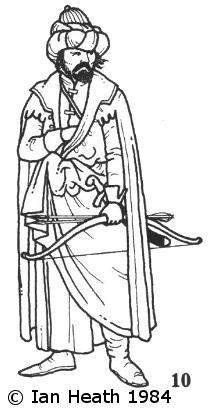
Try Amazon Audible Plus
 [Based on An Oriental Family by Albrecht Dürer, 1496] |
OTTOMAN AKINJI, 15th CENTURY
An extract from Armies of the Middle Ages, Volume 2by Ian Heath

 [Based on An Oriental Family by Albrecht Dürer, 1496] |
10. OTTOMAN AKINJI, 15th CENTURY
Though depicted on foot, this figure from a late-15th century woodcut by Dürer is in fact one of the swarm of irregular light cavalry which accompanied every Ottoman army in the field. The characteristic Turkish costume worn here, with its broad-collared, long-sleeved coat, was undoubtedly copied by the Ottomans from their Balkan subjects, who wore very similar dress (see 14, 68, 78, 80 and 95). Indeed, Pero Tafur described Rumelian Ottomans in the 1430s as ‘clad in the manner of the country’, in long cloaks and coats ‘open in front. These are made of fine woollen cloth, and of silk and brocades from Italy.’ He also says that they wore ‘boots of Damascene leather up to the knees, which are very hard, and to which the spurs are fixed’, plus turbans or caps, and furs of marten, sable, ermine and fox. Pictorial sources (the earliest I know of being a Venetian relief carving dated 1474) show that the long sleeves of the coat were usually either tied together behind the back or else stuffed through the belt.
This is the sort of costume worn even by Mehmed II himself in the 15th century portrait by Sinan Bey, in which the topcoat is blue with white collar and facings, the tunic (which differs in being of the crossover style worn by figure 1) is brown with red cuffs and borders, and the turban is white wrapped round a red cap.